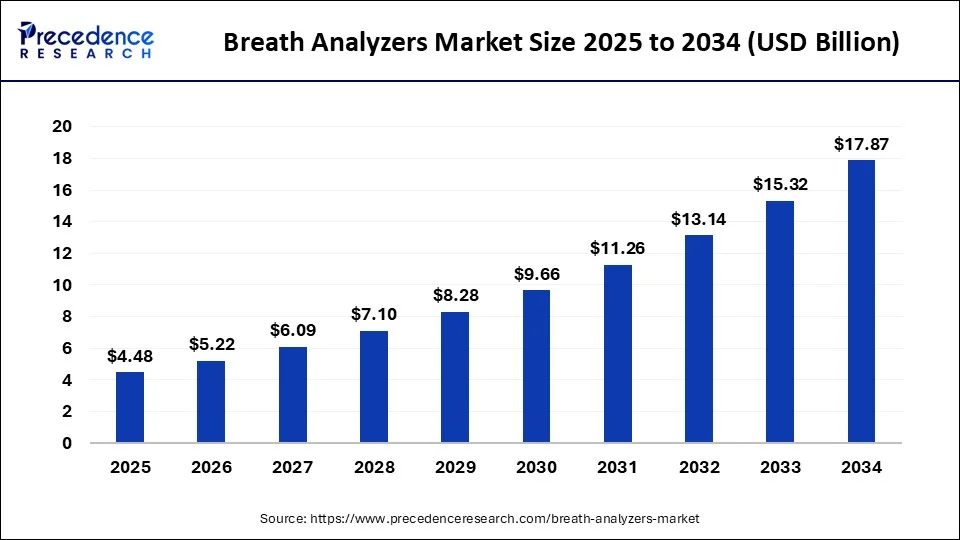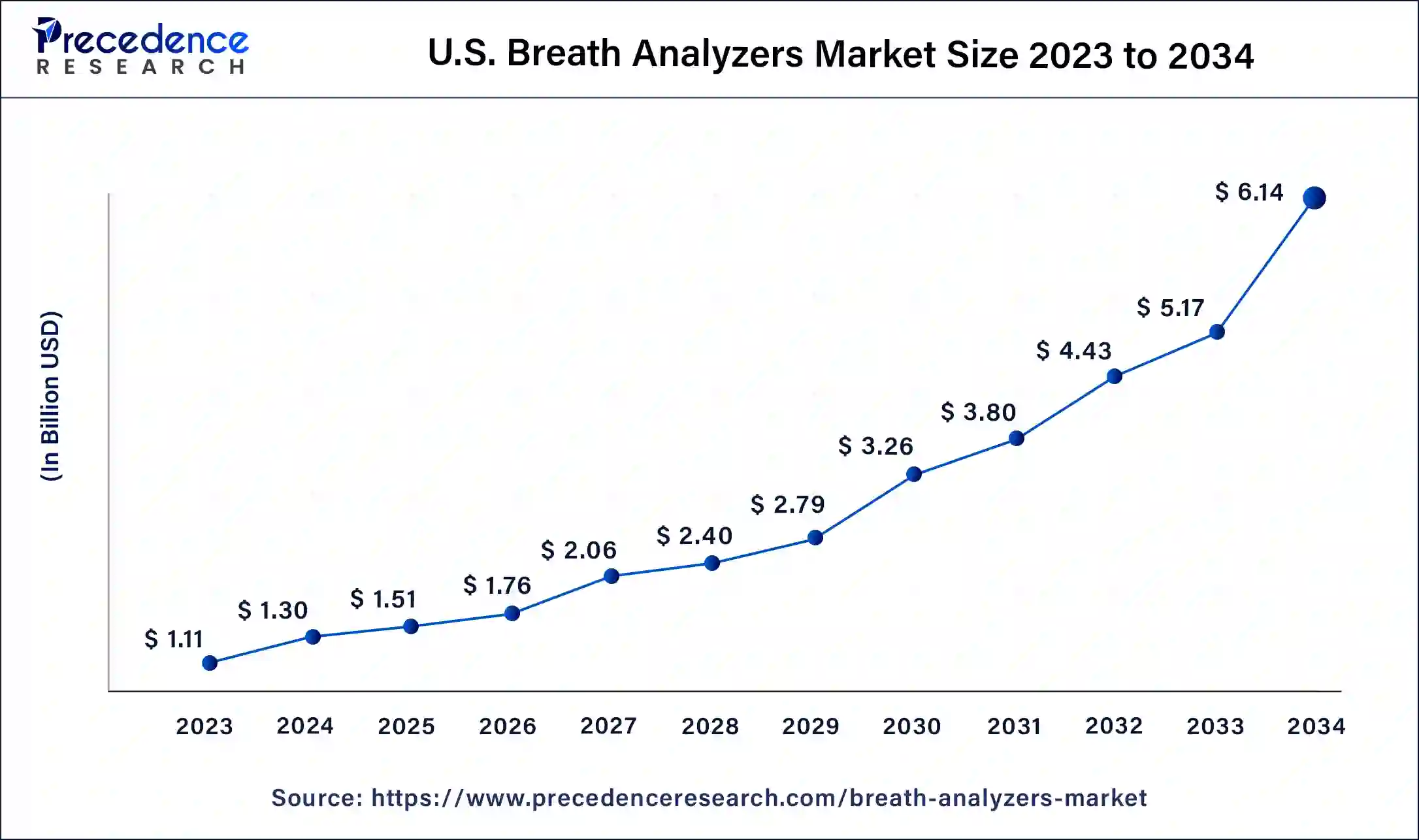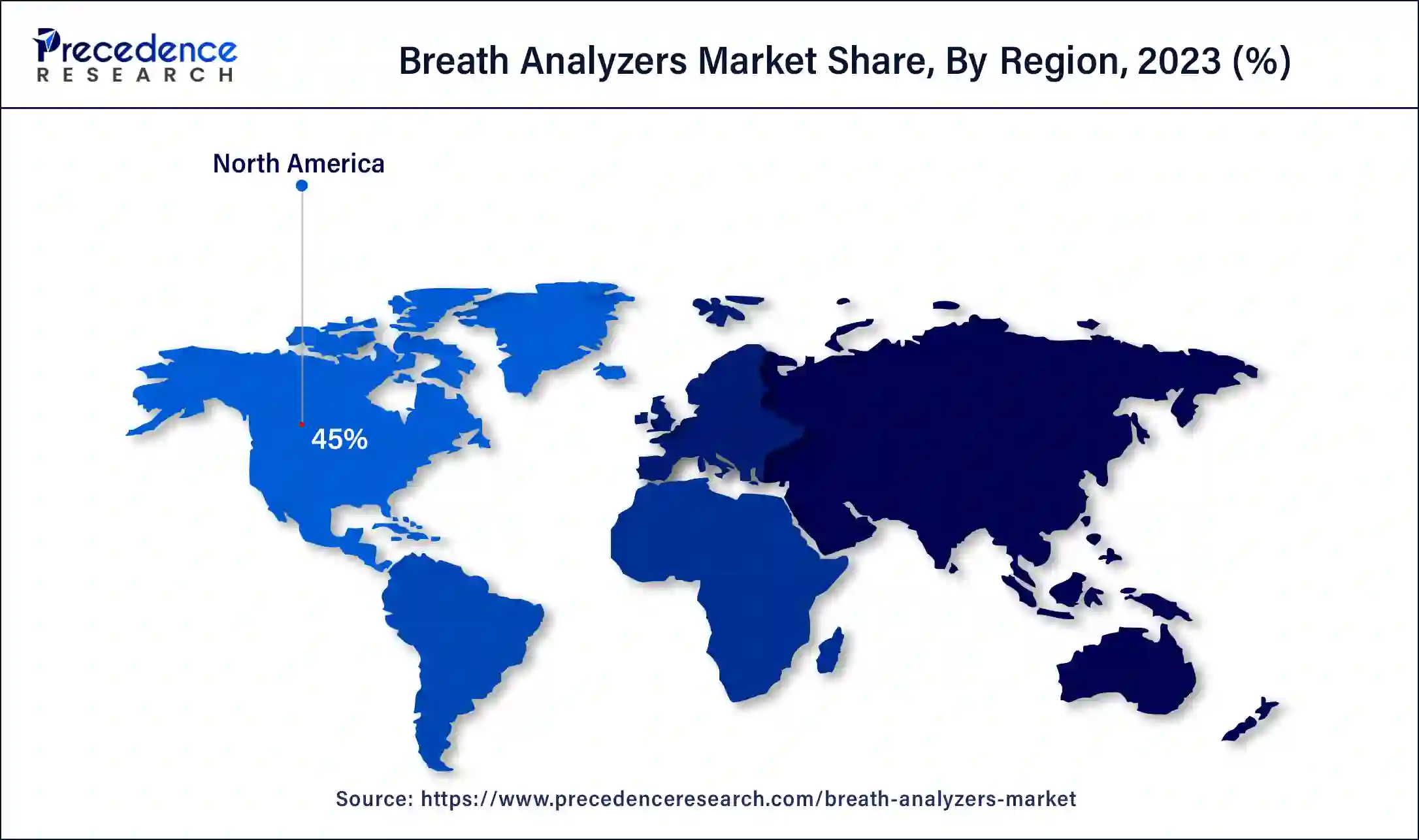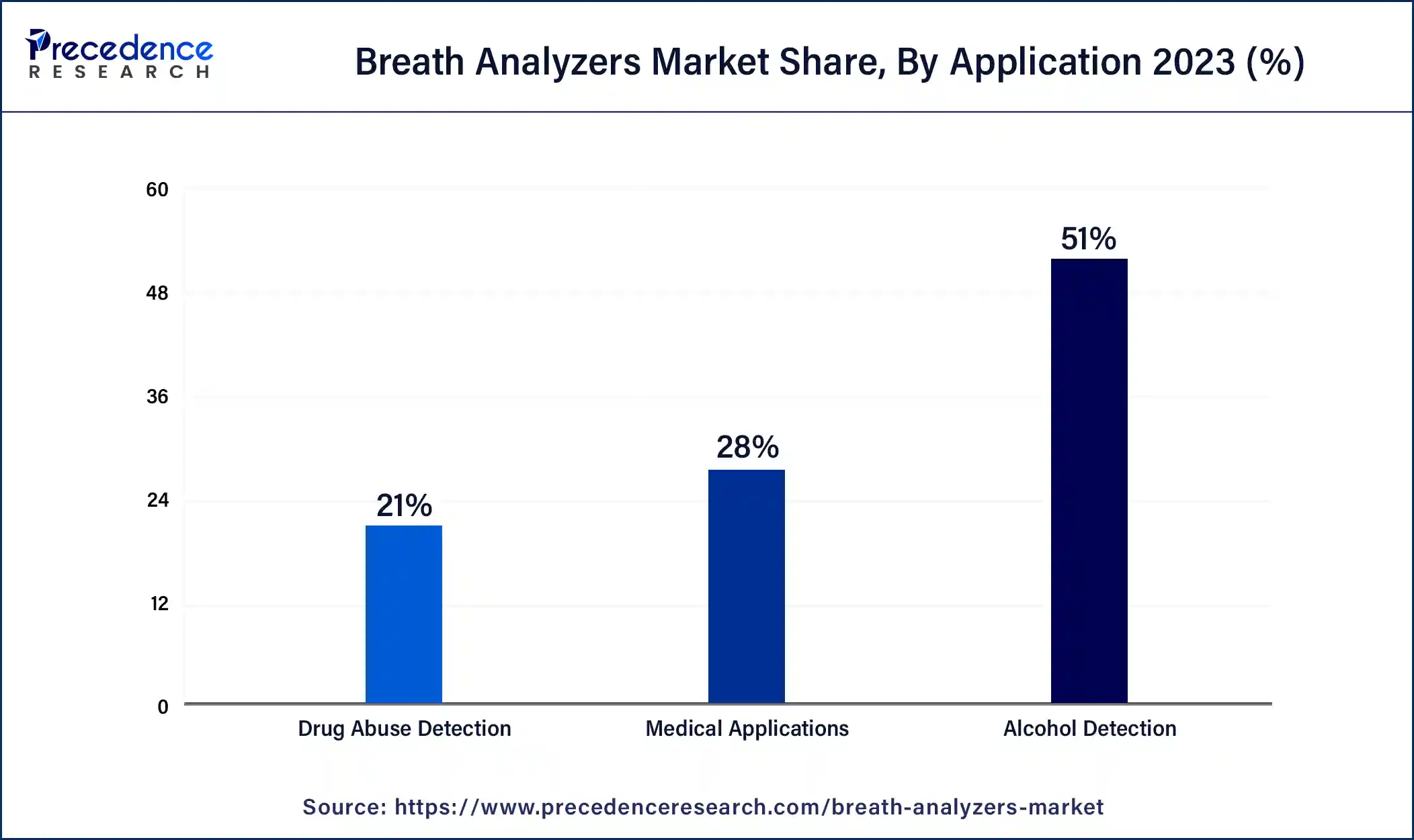List of Contents
Breath Analyzers Market Size and Forecast 2025 to 2034
The global breath analyzers market size is expected to be worth around USD 17.87 billion in 2034 from USD 3.84 billion in 2024, at a CAGR of 16.62% between 2025 and 2034. The North America breath analyzers market size reached USD 1.73 billion in 2024. The breath analyzers market demand is driven by rising legal awareness and enforcement of alcohol and drug addiction legislation.

Breath Analyzers Market Key Takeaway
- The global breath analyzers market was valued at USD 3.84 billion in 2024.
- It is projected to reach USD 17.87 billion by 2034.
- The breath analyzers market is expected to grow at a CAGR of 16.62% from 2025 to 2034.
- North America dominated the breath analyzers market with the largest market share of 45% in 2024.
- By technology, the fuel cell technology segment accounted for the largest market share of 35% in 2024.
- By technology, the semiconductor sensor segment is expected to grow at the fastest rate in the market over the forecast period.
- By application, the alcohol detection segment has held the market share of 51% in 2024.
- By application, the medical application segment is expected to grow at the fastest rate in the market over the forecast period.
U.S. Breath Analyzers Market Size and Growth 2025 to 2034
The U.S. breath analyzers market size was exhibited at USD 1.30 billion in 2024 and is projected to be worth around USD 6.14 billion by 2034, poised to grow at a CAGR of 16.79% from 2025 to 2034.

North America held the largest share of the market in 2024. North America's rising rates of drug and alcohol addiction have increased demand for trustworthy and efficient breath analyzers for both law enforcement and private use. Increased laws and enforcement tactics aimed at preventing drugged and drunk driving also support the expansion of the business. Advancements include breath analyzers that operate on smartphones, and the incorporation of artificial intelligence to improve analysis is becoming more and more common.
Government and non-government organizations are advocating the use of breath analyzers for personal safety through educational programs. The market is further propelled by government regulations requiring the use of breath analyzers in a number of sectors, including logistics and transportation. For professional and law enforcement applications, fuel cell technology is the best option due to its high accuracy and dependability.

Asia Pacific is observed to be the fastest growing area in the breath analyzers market during the forecast period. In the area, there is a growing need for breath analyzers due to strict laws against driving while intoxicated and increased alcohol use. The market is being stimulated by governments enacting more stringent legislation and increasing the frequency of roadside testing. Breath analyzers are becoming more widely used for medical purposes as people become more conscious of their fitness and health and realize how important it is to track certain health metrics.
Breath analyzers are becoming more accessible and user-friendly thanks to advancements in technology, such as the creation of more accurate and portable equipment. Devices that can identify a variety of substances, such as narcotics, alcohol, and other medical disorders, are considered advances. Partnerships and strategic alliances between businesses to increase their market share and diversify their product lines.
Market Overview
The industry devoted to the manufacture, marketing, and distribution of breath analyzer equipment is known as the breath analyzers market. These tools are intended to identify and quantify different compounds that are present in a person's breath. The main purpose of breath analyzers, which are frequently used by law enforcement for DUI (driving under the influence) inspections, is to detect alcohol levels in order to evaluate sobriety. These are frequently found in personal breathalyzers and are widely employed by law enforcement due to their excellent specificity and accuracy for alcohol.
The breath analyzers market is expected to develop as a result of factors such as rising public awareness of alcohol-related problems, tougher enforcement of drunk driving laws, technological advancements in breath analyzers, and growing applications in medical diagnostics. Use breath analysis in medical settings to identify conditions like diabetes and asthma. Also, the expanding use of workplace safety compliance and roadside alcohol testing by law enforcement. The market for breath analyzers is anticipated to rise further as the use of the devices spreads beyond alcohol testing and technology advances.
The breath analyzers market is expanding significantly due to rising worries about drunk driving, the demand for speedy and non-invasive diagnostic instruments, and other factors. Stricter laws require alcohol testing in a number of sectors, particularly the transportation sector. Miniaturization and the development of sophisticated sensors have made breath analyzers more portable and user-friendly. Additional market growth is probably going to be fueled by advancements in sensor technology and their growing use in the healthcare industry.
Breath Analyzers Market Growth Factors
- The need for the breath analyzers market is being driven by increased public awareness and stronger legislation regarding alcohol consumption and driving under the influence.
- Breath analyzers are becoming more and more necessary for medical diagnosis due to the rising prevalence of respiratory conditions, including asthma and chronic obstructive pulmonary disease (COPD).
- Stricter enforcement of laws related to DUI and workplace safety regulations are fueling the adoption of the breath analyzers market.
- Breath analyzers are becoming more widely used by law enforcement organizations around the world to enforce DUI laws, which is fueling the breath analyzers market expansion.
- The demand for breath analyzers is being driven by rising health consciousness and the need for non-invasive medical diagnostic instruments.
- Beyond just detecting alcohol, breath analyzers are being used for medical diagnoses of diseases like diabetes, TB, and Helicobacter pylori infection.
- The introduction of breath analyzers for routine driver inspections is a result of the transportation sector's emphasis on safety.
- People are increasingly employing personal breath analyzers to check their alcohol levels for health and safety purposes.
- The increasing urbanization and disposable incomes in emerging nations, especially in Asia Pacific and Latin America, offer substantial prospects for the breath analyzers market expansion.
Market Scope
| Report Coverage | Details |
| Market Size by 2034 | USD 17.87 Billion |
| Market Size in 2025 | USD 4.48 Billion |
| Market Size in 2024 | USD 3.84 Billion |
| Market Growth Rate from 2025 to 2034 | CAGR of 16.62% |
| Largest Market | North America |
| Base Year | 2024 |
| Forecast Period | 2025 to 2034 |
| Segments Covered | Technology, Application, and Regions |
| Regions Covered | North America, Europe, Asia-Pacific, Latin America, and Middle East & Africa |
Market Dynamics
Driver
Growing awareness of personal health monitoring
People are starting to take more responsibility for their health, which has increased demand for compact, user-friendly breath analyzers that can be used for a variety of health evaluations, such as measuring blood sugar levels, measuring alcohol levels, and even identifying conditions like gastrointestinal problems or asthma. Regular monitoring is necessary due to the rising prevalence of disorders, including diabetes, obesity, and respiratory ailments. Breath analyzers can help with this. Breath analyzers are becoming more widely accessible and reasonably priced as new businesses enter the market and those that are already there expand their product lines. In an effort to promote healthier lifestyles and save healthcare costs, employers and insurance companies are progressively integrating personal health monitoring devices into wellness initiatives.
Restraint
High costs of advanced devices
Advanced breath analyzers are more accurate and dependable because they use advanced technologies, including infrared spectrometry, fuel cell sensors, and semiconductor sensors. There are large R&D expenses associated with the creation, integration, and downsizing of these technologies. Strict regulatory requirements must be met by the breath analyzers market for medical or law enforcement applications in order to guarantee their accuracy and dependability.
Obtaining regulatory licenses necessitates extensive testing and certification, which raises the total cost. Modern breath analyzers need to be made using high-quality materials to guarantee their accuracy and longevity. The cost of these devices is further increased by the fact that precision engineering and quality control procedures are frequently used throughout the manufacturing process.
Opportunity
Personalized medicine and healthcare
In the context of the breath analyzers market, personalized medicine and healthcare are becoming more and more important. These tools provide non-invasive methods for examining biomarkers in exhaled breath, revealing details about a person's metabolic and general health. With the ability to monitor chronic problems, detect diseases early, and create individualized treatment plans based on each patient's own biological profile, this technology has the potential to completely transform healthcare.
Finding biomarkers for metabolic conditions, respiratory illnesses, and even some forms of cancer are important applications. Personalized healthcare via breath analysis is a promising sector of development, propelled forward by innovations in sensor technology and data analytics.
Technology Insights
The fuel cell technology segment accounted for the largest share of the breath analyzers market in 2024. The accuracy and dependability of breath analyzers have been improved with the use of fuel cell technology. Fuel cells work by utilizing a chemical process, including oxygen and a fuel source, such as ethanol, to directly transform chemical energy into electrical energy. Compared to conventional semiconductor-based sensors, this technology provides breath analyzers with better accuracy by enabling exact detection of an individual's alcohol levels in their breath.
Fuel cells are useful in legal and medical contexts where exact readings are essential because they offer extremely accurate estimations of the amount of alcohol present in breath samples. Fuel cell technology is becoming more and more popular because of the growing need for precise alcohol detection in a variety of applications, including clinical diagnostics, law enforcement, and occupational safety.
The semiconductor sensor segment is expected to grow at the fastest rate in the breath analyzers market over the forecast period. The breath analyzers market has a sizable semiconductor sensor section. Because semiconductor sensors are compact, inexpensive, and capable of precisely detecting a wide range of gases including ethanol and other volatile organic chemicals found in breath they are frequently utilized. Because of their dependability and short reaction times, they are frequently used in industrial safety instruments, personal breathalyzers, and law enforcement equipment. The need for portable, user-friendly gadgets, tighter restrictions on alcohol consumption, and developments in sensor technology are all contributing to the growth of this market.
Application Insights
The alcohol detection segment held the largest share of the breath analyzers market in 2024. The breath analyzers market's alcohol detection segment is centered on instruments made to determine the blood alcohol concentration (BAC) of breath samples. These devices are essential for maintaining safety and adhering to alcohol consumption laws in a variety of industries, including law enforcement, the workplace, and healthcare. Significant elements impacting this market include developments in sensor technology, laws controlling breathalyzer testing, and growing public awareness of the risks associated with driving while intoxicated. Innovations in portable and handheld breath analyzers are also being seen in this industry, increasing their usability and accessibility for a variety of applications.

The medical application segment is expected to grow at the fastest rate in the breath analyzers market over the forecast period. In many applications for monitoring and diagnosis, the medical application sector is essential. By using breath analysis, these analyzers may identify a variety of medical diseases and indicators. They are used to determine a person's alcohol consumption, particularly in circumstances related to law enforcement and rehabilitation. Breath analyzers are being used more often to diagnose diseases like diabetes, asthma, and some gastrointestinal ailments by looking for particular biomarkers in exhaled breath.
Because infections release volatile organic compounds (VOCs), they may be able to identify infectious diseases. Additionally, analyzers using breath biomarkers are being investigated for general health monitoring and wellness assessments. The development of sensor technology, the growing emphasis on non-invasive diagnostics, and the increasing need for individualized medicine solutions are the main drivers of the medical segment's growth.
Breath Analyzers Market Companies
- Intoximeters
- Lifeloc technologies
- Aker's bioscience
- Alere
- Alcolizers pty. Ltd
- Bedfont Scientific Ltd.
- Quest Products Inc.
- Alcopro
- MPD, INC.
Recent Developments
- In June 2024, in Bengaluru, Coromandel International introduced ‘Paramfos Plus,' a new complex-grade fertilizer supplemented with magnesium. The fertilizer known as ‘Paramfos Plus' has a composition of 16% nitrogen, 20% phosphorus, 13% sulfur, and an extra 0.6% magnesium. The additional magnesium increases the formation of chlorophyll, photosynthesis, and plant vegetative development, which improves yield and quality.
- In May 2024, the ground-breaking wearable breath analyzer PACER, from innovative fitness technology company Neumafit, gives athletes never-before-seen performance insights. Fitness technology pioneer Neumafit is excited to announce the impending Kickstarter launch of its ground-breaking device, PACER. The world's most intelligent wearable breath analyzer, PACER, is poised to transform how fitness enthusiasts and athletes track and improve their performance.
Segment Covered in the Report
By Technology
- Fuel Cell Technology
- Semiconductor Sensor
- Infrared (IR) Spectroscopy
- Others
By Application
- Drug Abuse Detection
- Alcohol Detection
- Medical Applications
By Geography
- North America
- Asia Pacific
- Europe
- Latin America
- Middle East & Africa
For inquiries regarding discounts, bulk purchases, or customization requests, please contact us at sales@precedenceresearch.com
Frequently Asked Questions
Ask For Sample
No cookie-cutter, only authentic analysis – take the 1st step to become a Precedence Research client